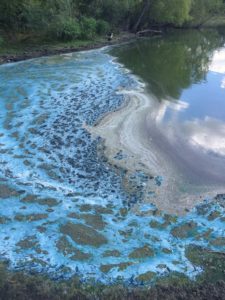More Info & Photos of Blue-Green algae
Non-Herbicide Management Options
1. Physical Management Options
Floating, Blue-Green algae cannot be mechanically or physically controlled, except by replacing the pond water. Exchange of water from a well or other source that does not have an algae bloom will dilute the algae in the pond. This is not a practical option for most pond owners unless their ponds are very small and they have wells close by.
Non-toxic dyes or colorants prevent or reduce aquatic plant growth by limiting sunlight penetration, similar to fertilization. However, dyes do not enhance the natural food chain and will suppress the natural food chain of the pond.
Some examples of non-toxic dyes and other products include but are not limited to:
2. Biological Management Options
While many microscopic animals (zooplankton) eat Blue-Green algae, there are no practical ways to increase their populations, so no biological control is possible.
Herbicide Control Options
Always read the product label for directions and precautions, as the label is the law. Click on the name of the product to see the label. Read the label for specific water use restrictions.
The active ingredients that have been successful in treating Blue-Green algae include:
- Copper Sulfate (Rated: Excellent)
- Copper Chelated Complexes (Rated: Excellent)
- Alkylamine salts of Endothall (Rated: Good)
- Sodium Carbonate Peroxyhydrate (Rated: Good)
These rating are based upon the U.S. Army Corps of Engineers aquatic herbicide trials.
1) Copper Sulfate
Copper Sulfate or “blue stone” is probably the most commonly used algal treatments because of its availability and low cost. Copper sulfate comes in several forms depending on how finely it is ground. Smaller crystals will dissolve easier than larger crystals. In very hard water it is difficult to use copper sulfate because it binds with the calcium, precipitates out of solution, and renders the copper ineffective as an algaecide.
All copper compounds can be toxic to fish if used above labeled rates and can be toxic in soft or acidic waters even at label rates. Before using copper it is best to test the pond water’s alkalinity and adjust copper treatments to alkalinity concentrations. For additional information on using copper sulfate see the SRAC #410 Calculating Treatments for Ponds and Tanks.
Common trade or product names include but are not limited to:
2) Copper Chelated Complexes
All copper compounds can be toxic to fish if used above labeled rates and can be toxic in soft or acidic waters even at label rates. Before using copper it is best to test the pond water’s alkalinity and adjust copper treatments to alkalinity concentrations. For additional information on using copper sulfate see the SRAC #410 Calculating Treatments for Ponds and Tanks.
Common trade or product names include but are not limited to:
3) Alkylamine salts of Endothall (Rated: Good)
Alkylamine salts of endothall come in both liquid and granular forms. It is a contact herbicide.
Common trade and product names include but are not limited to:
Hydrothol can be toxic to fish.
4) Sodium Carbonate Peroxyhydrate (Rated: Good)
These are contact herbicides for control of some algae and have been shown to kill golden algae. Hydrogen peroxide is the active agent in this algaecide. SCP is not effective on the macroalgaes, Chara or Nitella, or on any higher plants.
Common trade and product names include but are not limited to:
Precautions
One danger with any chemical control method is the chance of an oxygen depletion after the treatment caused by the decomposition of the dead plant material. Oxygen depletion can kill fish in the pond. If the pond is heavily infested with weeds, it may be possible (depending on the herbicide chosen) to treat the pond in sections and let each section decompose for about two weeks before treating another section. Aeration, particularly at night, for several days after treatment may help control the oxygen depletion.
One common problem in using aquatic herbicides is determining area and/or volume of the pond or area to be treated. To assist you with these determinations see SRAC #103 Calculating Area and Volume of Ponds and Tanks.
Many aquatically registered herbicides have water use restrictions (See General Water Use Restrictions).
To see the labels for these products click on the name. Always read and follow all label directions. Check label for specific water use restrictions.
Questions?
If you need assistance, contact the Ag & Natural Resources agent in your county or hire a professional.
